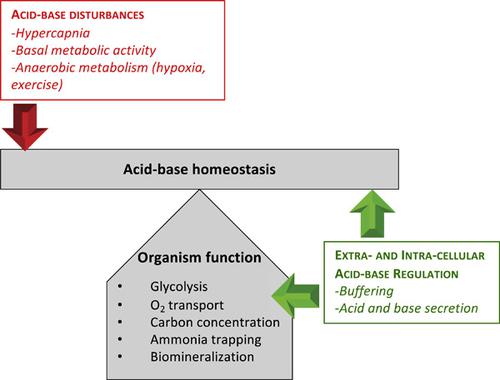当前位置:
X-MOL 学术
›
J. Exp. Zool. Part A
›
论文详情
Our official English website, www.x-mol.net, welcomes your feedback! (Note: you will need to create a separate account there.)
Evolutionary links between intra- and extracellular acid-base regulation in fish and other aquatic animals.
Journal of Experimental Zoology Part A ( IF 2.8 ) Pub Date : 2020-05-26 , DOI: 10.1002/jez.2367 Martin Tresguerres 1 , Alexander M Clifford 1 , Till S Harter 1 , Jinae N Roa 1 , Angus B Thies 1 , Daniel P Yee 1 , Colin J Brauner 2
Journal of Experimental Zoology Part A ( IF 2.8 ) Pub Date : 2020-05-26 , DOI: 10.1002/jez.2367 Martin Tresguerres 1 , Alexander M Clifford 1 , Till S Harter 1 , Jinae N Roa 1 , Angus B Thies 1 , Daniel P Yee 1 , Colin J Brauner 2
Affiliation

|
The acid–base relevant molecules carbon dioxide (CO2), protons (H+), and bicarbonate (HCO3−) are substrates and end products of some of the most essential physiological functions including aerobic and anaerobic respiration, ATP hydrolysis, photosynthesis, and calcification. The structure and function of many enzymes and other macromolecules are highly sensitive to changes in pH, and thus maintaining acid–base homeostasis in the face of metabolic and environmental disturbances is essential for proper cellular function. On the other hand, CO2, H+, and HCO3− have regulatory effects on various proteins and processes, both directly through allosteric modulation and indirectly through signal transduction pathways. Life in aquatic environments presents organisms with distinct acid–base challenges that are not found in terrestrial environments. These include a relatively high CO2 relative to O2 solubility that prevents internal CO2/HCO3− accumulation to buffer pH, a lower O2 content that may favor anaerobic metabolism, and variable environmental CO2, pH and O2 levels that require dynamic adjustments in acid–base homeostatic mechanisms. Additionally, some aquatic animals purposely create acidic or alkaline microenvironments that drive specialized physiological functions. For example, acidifying mechanisms can enhance O2 delivery by red blood cells, lead to ammonia trapping for excretion or buoyancy purposes, or lead to CO2 accumulation to promote photosynthesis by endosymbiotic algae. On the other hand, alkalinizing mechanisms can serve to promote calcium carbonate skeletal formation. This nonexhaustive review summarizes some of the distinct acid–base homeostatic mechanisms that have evolved in aquatic organisms to meet the particular challenges of this environment.
中文翻译:

鱼和其他水生动物中细胞内和细胞外酸碱调节之间的进化联系。
酸碱相关分子的二氧化碳(CO 2),质子(H +)和碳酸氢盐(HCO 3 - )是一些最基本的生理功能,包括有氧和无氧呼吸,ATP水解,光合作用底物和终产物,和钙化。许多酶和其他大分子的结构和功能对pH的变化高度敏感,因此面对新陈代谢和环境干扰,维持酸碱稳态对于正确的细胞功能至关重要。在另一方面,CO 2,H +,和HCO 3 -直接通过变构调节和间接通过信号转导途径对各种蛋白质和过程具有调节作用。水生环境中的生物给生物带来了独特的酸碱挑战,这是陆地环境所没有的。这些包括一个相对高的CO 2相对于与O 2的溶解度,防止内部CO 2 / HCO 3 -累积到缓冲液pH,低级Ô 2,其可以有利于厌氧代谢含量,和可变的环境CO 2,pH值和O 2需要动态调整酸碱稳态机制的水平。此外,一些水生动物有意创造出酸性或碱性微环境,以驱动特定的生理功能。例如,酸化机制可以增强红细胞的O 2传递,导致排泄或浮力的氨捕获,或导致CO 2积累以促进内共生藻类的光合作用。另一方面,碱化机制可以促进碳酸钙骨骼的形成。这份非详尽的综述总结了在水生生物中进化出的一些独特的酸碱稳态机制,以应对这种环境的特殊挑战。
更新日期:2020-05-26
中文翻译:

鱼和其他水生动物中细胞内和细胞外酸碱调节之间的进化联系。
酸碱相关分子的二氧化碳(CO 2),质子(H +)和碳酸氢盐(HCO 3 - )是一些最基本的生理功能,包括有氧和无氧呼吸,ATP水解,光合作用底物和终产物,和钙化。许多酶和其他大分子的结构和功能对pH的变化高度敏感,因此面对新陈代谢和环境干扰,维持酸碱稳态对于正确的细胞功能至关重要。在另一方面,CO 2,H +,和HCO 3 -直接通过变构调节和间接通过信号转导途径对各种蛋白质和过程具有调节作用。水生环境中的生物给生物带来了独特的酸碱挑战,这是陆地环境所没有的。这些包括一个相对高的CO 2相对于与O 2的溶解度,防止内部CO 2 / HCO 3 -累积到缓冲液pH,低级Ô 2,其可以有利于厌氧代谢含量,和可变的环境CO 2,pH值和O 2需要动态调整酸碱稳态机制的水平。此外,一些水生动物有意创造出酸性或碱性微环境,以驱动特定的生理功能。例如,酸化机制可以增强红细胞的O 2传递,导致排泄或浮力的氨捕获,或导致CO 2积累以促进内共生藻类的光合作用。另一方面,碱化机制可以促进碳酸钙骨骼的形成。这份非详尽的综述总结了在水生生物中进化出的一些独特的酸碱稳态机制,以应对这种环境的特殊挑战。


























 京公网安备 11010802027423号
京公网安备 11010802027423号